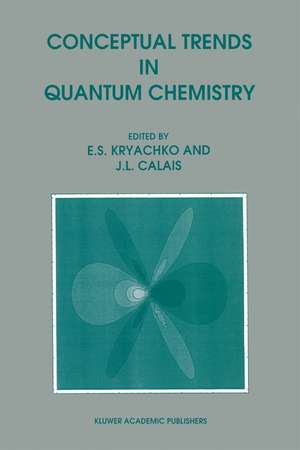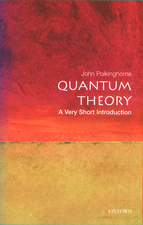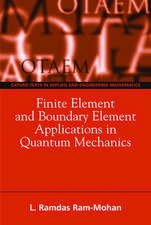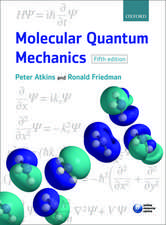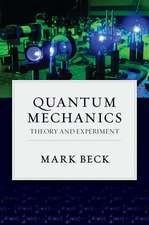Conceptual Trends in Quantum Chemistry
Editat de Eugene S. Kryachko, Jean-Louis Calaisen Limba Engleză Paperback – 9 dec 2011
Preț: 386.22 lei
Nou
Puncte Express: 579
Preț estimativ în valută:
73.90€ • 77.01$ • 61.19£
73.90€ • 77.01$ • 61.19£
Carte tipărită la comandă
Livrare economică 03-17 aprilie
Preluare comenzi: 021 569.72.76
Specificații
ISBN-13: 9789401043670
ISBN-10: 9401043671
Pagini: 250
Ilustrații: XII, 250 p.
Dimensiuni: 160 x 240 x 17 mm
Greutate: 0.37 kg
Ediția:1994
Editura: SPRINGER NETHERLANDS
Colecția Springer
Locul publicării:Dordrecht, Netherlands
ISBN-10: 9401043671
Pagini: 250
Ilustrații: XII, 250 p.
Dimensiuni: 160 x 240 x 17 mm
Greutate: 0.37 kg
Ediția:1994
Editura: SPRINGER NETHERLANDS
Colecția Springer
Locul publicării:Dordrecht, Netherlands
Public țintă
ResearchCuprins
Molecules in Magnetic Fields: Fundamental Aspects.- 1. Introduction.- 2. The Hamiltonian and Its Constants of Motion.- 3. The Pseudoseparation of the Center of Mass Motion.- 4. Adiabatic Separation of Electronic and Nuclear Motion in the Presence of a Magnetic Field.- 5. Molecular Symmetries and Crossings of Potential Energy Surfaces in a Magnetic Field.- 6. Atomic Orbital Basis Set for the Numerical Calculation of Properties of Molecules in Strong Magnetic Fields.- 7. Conclusions and Outlook.- References.- The Decoupling of Nuclear from Electronic Motions in Molecules.- 1. Introduction.- 2. The Removal of Translational Motion.- 3. Distinguishing Electronic and Nuclear Motions.- 4. The Body-Fixed Hamiltonian.- 5. Separating Electronic and Nuclear Motions.- 6. The Clamped Nucleus Hamiltonian.- 7. Difficulties and Divergences.- 8. Conclusions.- References.- The Status of Density Functional Theory for Chemical Physics.- 1. Introduction.- 2. Traits and Uses of Density Functional Theory.- 3. Limitations of the DFT-LSDA.- 4. Some Current Issues.- References.- String Model of Chemical Reactions.- 1. Introduction.- 2. Differential Geometry of the String Model.- 3. Quantum Mechanics of the String Model.- 4. Vibronic Hamiltonian.- 5. External Field Effects.- 6. Conclusion.- References.- Molecular Structure — Property Relations. Three Remarks on Reactivity Indices.- 1. Introduction.- 2. Perturbabilities and Density Matrix Elements.- 3. Physical Significance of Atomic Populations.- 4. A Reactivity Index from the Supermolecule Approach.- References.- Hyperspherical Harmonics; Some Properties and Applications.- 1. Introduction.- 2. Harmonic Polynomials.- 3. Generalized Angular Momentum.- 4. Angular Integrations.- 5. Hyperspherical Harmonics.- 6. Gegenbauer Polynomials.- 7. TheHydrogen Atom in Reciprocal Space.- 8. Many-Center Coulomb Potentials.- 9. Hyperspherical Sturmian Basis Functions.- 10. Evaluation of the Z-matrix.- 11. Iteration of the Wave Equation, and “Primary” Harmonics.- References.- The Nature of The Chemical Bond 1993. There Are No Such Things as Orbitals!.- 1. Introduction.- 2. Quantum Laws and Quantum Theories.- 3. Application of Quantum Mechanics to Atomic and Molecular Structure.- 4. Implications for Chemical Education.- Appendix — Interpretation of Photoelectron Spectra.- References.- A Phase Space Essay.- 1. Introduction.- 2. The Classical Phase Space.- 3. Some Aspects of Quantum Mechanics.- 4. Phase — Space Representations.- References.- The Wavelet Transform: A New Mathematical Tool for Quantum Chemistry.- 1. Introduction.- 2. From Fourier Analysis to Wavelet Analysis.- 3. Application of Wavelets in Quantum Chemistry.- 4. Conclusion.- References.
Recenzii
`... serious research groups in quantum chemistry should have access to this book, and it should be on the shelves of all self-respecting University libraries. The book is recommended for a specialist audience and the second volume is awaited with interest.'
Structural Chemistry, 6:4-5, 1995
Structural Chemistry, 6:4-5, 1995
